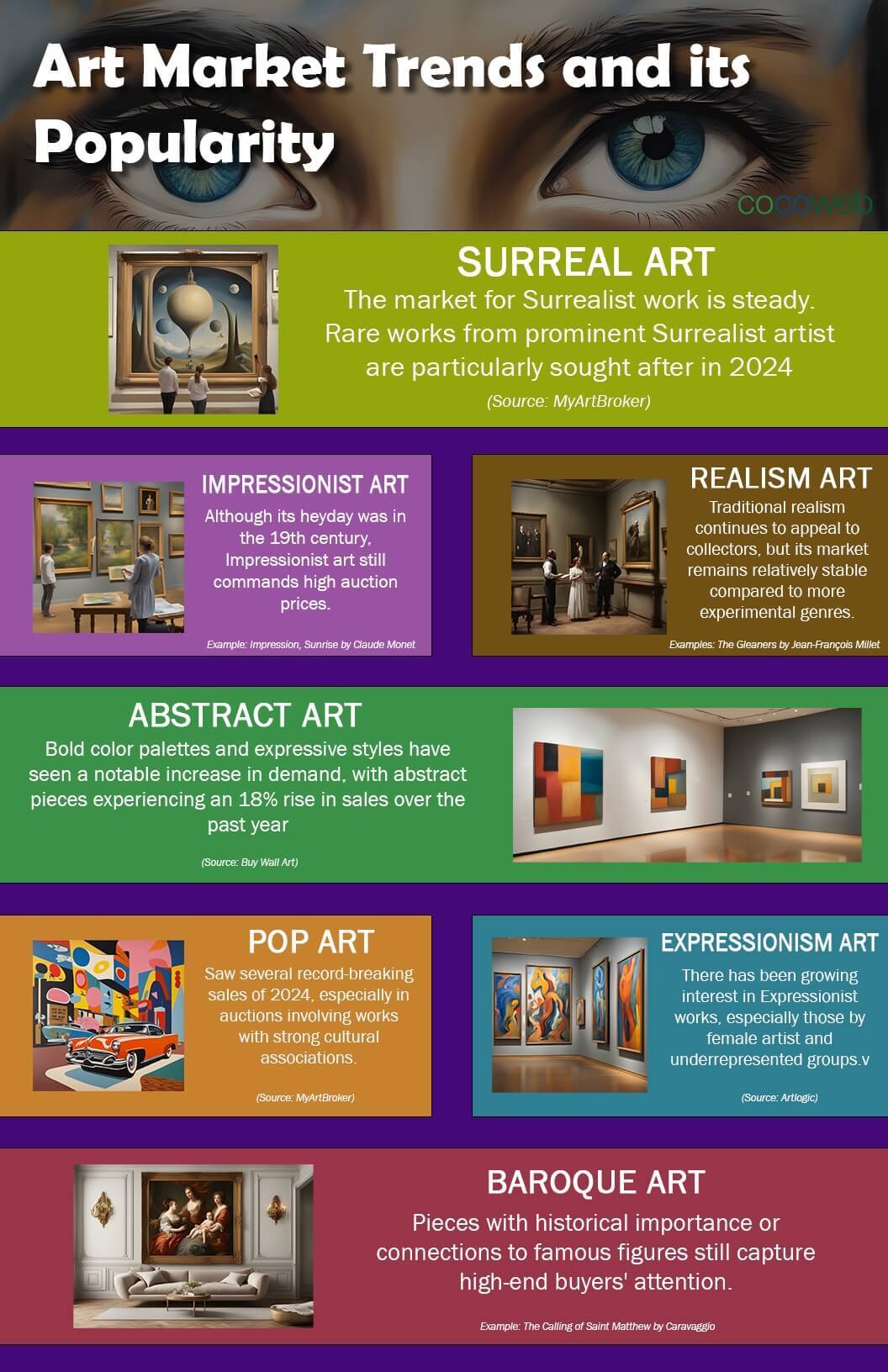A Guide to Art Movements: From Realism to Pop Art


1. Realism (19th Century - Present)
- Key Features:
- True-to-life representation of people, objects, and scenes.
- Subjects are often working-class people, nature, and everyday activities.
- Attention to light, shadow, texture, and anatomy.
- Often emphasizes social realities and moral themes.
- Notable Artists: Jean-François Millet, Gustave Courbet.
- Example: The Gleaners by Jean-François Millet.
- Tip for Identification: Look for photographic quality and highly detailed, realistic elements.
2. Impressionism (Late 19th Century)
- Key Features:
- Light and color are more important than precise details.
- Often focuses on natural landscapes, cityscapes, and leisure scenes.
- Visible, small brushstrokes that capture the fleeting effects of light and atmosphere.
- Colors are often blended optically (by the eye) rather than on the palette.
- Notable Artists: Claude Monet, Pierre-Auguste Renoir.
- Example: Impression, Sunrise by Claude Monet.
- Tip for Identification: Look for visible brushstrokes and a focus on light rather than sharp lines or details.
3. Abstract (Early 20th Century - Present)
- Key Features:
- Emphasizes line, shape, and color over representational forms.
- Often completely non-representational, but can include suggestions of figures or landscapes.
- Focus on composition and emotions rather than depicting the physical world.
- Can range from minimalist to complex geometric patterns.
- Notable Artists: Wassily Kandinsky, Piet Mondrian.
- Example: Composition VII by Wassily Kandinsky.
- Tip for Identification: If the focus is purely on shapes, colors, and forms with no recognizable subject, it’s abstract.
4. Cubism (Early 20th Century)
- Key Features:
- Breaks objects into geometric shapes and shows multiple perspectives simultaneously.
- Often lacks depth, using flattened, overlapping planes.
- Focus on abstracted forms and deconstructed subjects, often viewed from different angles.
- Muted colors in Analytical Cubism; bold, vibrant colors in Synthetic Cubism.
- Notable Artists: Pablo Picasso, Georges Braque.
- Example: Les Demoiselles d'Avignon by Pablo Picasso.
- Tip for Identification: Look for fragmented, angular shapes that depict objects from multiple angles.
5. Surrealism (1920s - Present)
- Key Features:
- Merges dream-like, irrational imagery with realistic details.
- Uses fantastic, unexpected combinations of objects, often symbolic.
- Juxtaposes unrelated elements, aiming to express the subconscious mind.
- Common themes include fantasy, dreams, and psychological states.
- Notable Artists: Salvador Dalí, René Magritte.
- Example: The Persistence of Memory by Salvador Dalí.
- Tip for Identification: If the painting looks dream-like, unreal, or bizarre, often blending reality with fantasy, it’s surrealism.
6. Expressionism (Late 19th Century - Early 20th Century)
- Key Features:
- Exaggerated forms and colors to convey emotional experience rather than reality.
- Often reflects feelings of anxiety, turmoil, or inner psychological states.
- Can feature distorted figures and dramatic compositions.
- The use of bold, clashing colors to evoke a visceral emotional response.
- Notable Artists: Edvard Munch, Egon Schiele.
- Example: The Scream by Edvard Munch.
- Tip for Identification: If the colors and forms seem distorted or unnatural to evoke intense emotions, it’s expressionism.
7. Pop Art (1950s - 1960s)
- Key Features:
- Inspired by mass media, consumer culture, and advertising.
- Uses bold, bright colors and flat imagery often taken from everyday objects, comic strips, or famous figures.
- Often comments on consumerism, celebrity culture, or the superficiality of society.
- Repetition of images or objects is common (e.g., soup cans, celebrities).
- Notable Artists: Andy Warhol, Roy Lichtenstein.
- Example: Marilyn Diptych by Andy Warhol.
- Tip for Identification: If you see bold, graphic-like depictions of consumer products or famous icons, you’re likely looking at pop art.
8. Baroque (17th Century)
- Key Features:
- Dramatic use of light and shadow (chiaroscuro), creating high contrast.
- Focuses on dynamic movement and theatricality.
- Often used for religious, mythological, or historical scenes with intense emotions.
- Rich, deep colors and elaborate details.
- Notable Artists: Caravaggio, Peter Paul Rubens.
- Example: The Calling of Saint Matthew by Caravaggio.
- Tip for Identification: Look for highly dramatic lighting, action-packed scenes, and emotional intensity.


